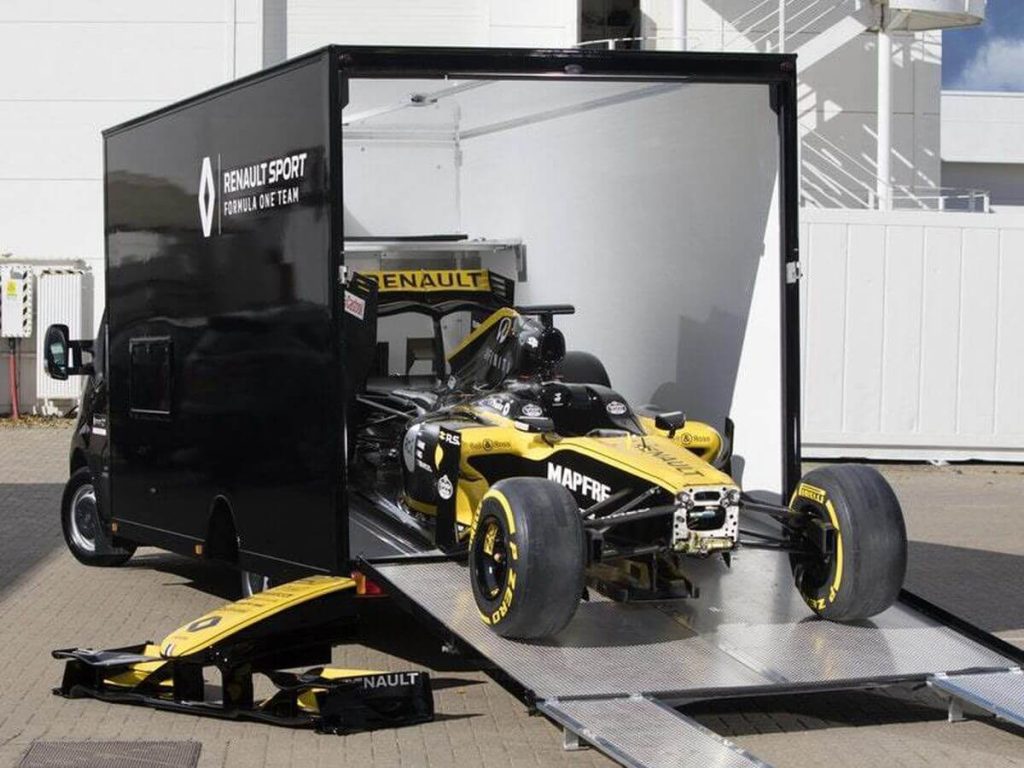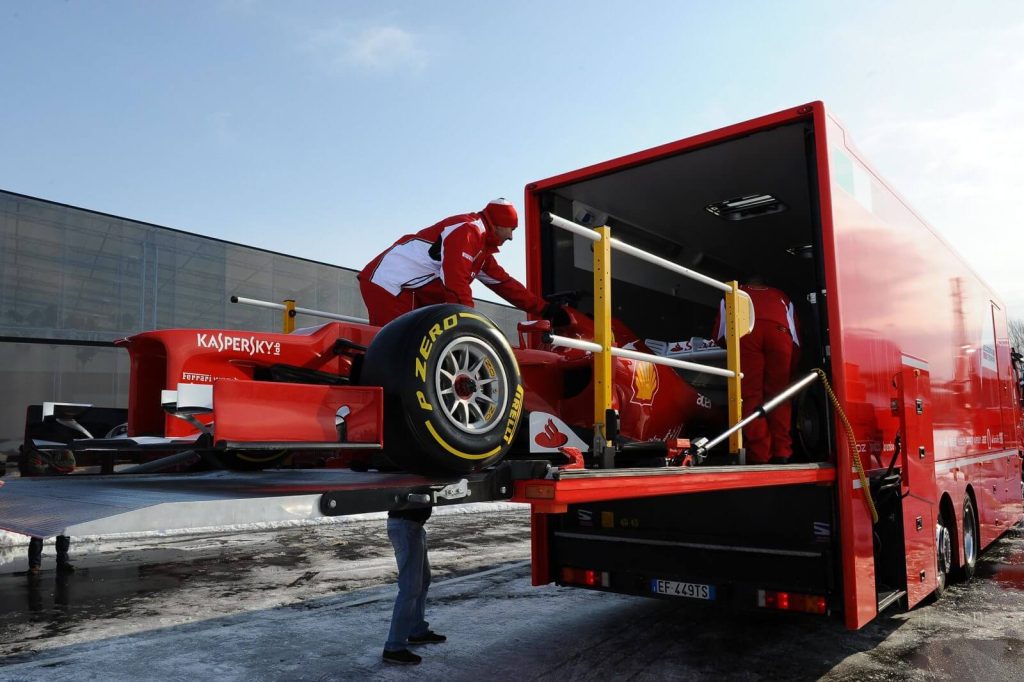The excitement of watching powerful engines roar through tight corners at exhilarating speeds and overtaking the competitor is a thrilling spectacle no F1 fan wants to miss.
However, the most shocking moment for me, when I started watching the F1 race was witnessing the pit crew members execute tire changes with seemingly lightning speed within seconds.
But that quick execution made me wonder how these high-performance machines make it to the racetracks across the globe. (how F1 cars are transported)
For those curious about the same, this blog delves into the behind-the-scenes of Formula 1 racing—the marvel of logistics. It explains how F1 cars are transported across continents within a few hours, the various modes of transportation, the equipment they carry, and the speed at which they reach the venues. Read on to uncover the F1 logistics saga.
How Does Transporting F1 Cars across Continents Work?
This year (2023), F1 has the highest number of races this year, 23 spread across the continent. It starts with the Bahrain Grand Prix in March and lasts till November, concluding with the season finale in Abu Dhabi. Matches are held almost every alternate weekend.
As for the transportation of F1 cars, they are the most valuable cargo. They fit into a box divided by a pallet. This diagonal pallet can have two cars, one above the other. The crew put it at such an upward elevated angle that it is protected from jumps or bounces.
Now that we know how race cars are moved let’s explore how F1 cars are transported to the race venue.

The End-To-End Process of Transporting F1 Cars to the Race Venue
To gain a comprehensive understanding of the end-to-end process, let’s delve into a specific instance, the race held in England from the 7th to the 9th of July. Once the race concludes, F1 cars undergo swift dismantling, and FIA officials conduct meticulous inspections to ensure technical compliance, guarding against any potential malpractices by the teams. Afterward, fluids are drained from the cars, and specific parts are carefully boxed, ready for shipment approximately a week before the upcoming race.
For example, if the next race is in Budapest on the 21st of July, the cars are expected to reach Budapest by the 14th of July. Upon receiving their pallets, the teams take on the task of reassembling the cars, which then undergo further technical checks before the race.
In the interest of fairness and safety, the teams’ crates are strategically positioned in the pit lane of the venue and strictly kept off-limits until all teams’ cargo has been successfully delivered. This ensures an equal playing field and maintains a secure environment for all teams throughout the F1 racing event.
What are Critical and Non-critical Parts of F1 Cars?
The entire logistic game is not just about transporting the F1 cars but also extends to the components related to them. Which are categorized into two types: critical and non-critical.
Critical parts have a direct impact on the car’s performance, including
- Chassis
- Tires
- Engines
- Wings
- Gearboxes
- Computers
- IT racks
On the other hand, non-critical parts consist of components that do not directly affect the car’s performance but can have indirect effects. These include garage parts like tools and jacks. Non-critical parts are usually less expensive than critical parts, and teams typically carry multiple sets, often around 5 sets.
On the Move: Discovering the 3 Best Methods for Transporting F1 Cars across Continents
Shipping cars across the country is challenging, so transporting F1 cars with critical and non-critical parts across continents is a commendable feat. Striving for error-free execution is essential to carry out such an important mission.
While cost-wise, the sea route proves effective, air transportation’s eagle-like speed is unmatched when meeting timelines. The road route is only chosen when the Grand Prix is organized in Europe, where almost all teams have their bases set up.
Additionally, DHL is assisting Formula 1 with sustainable energy options, such as biofuel trucks, to achieve its ambitious target of becoming carbon neutral by 2030.
Road Route: A Cost-Effective and Efficient Solution for F1 Car Transport
When races are scheduled back-to-back and located within the same continent, road transport becomes the go-to option. This choice involves transporting the F1 cars and non-critical parts required for the races.
Teams often employ multiple drivers to ensure seamless and continuous travel during tightly scheduled races, enabling non-stop journeys.
Despite being the cheaper and safer option, road races pose a threat from uncertainties like strong winds and heavy rainfall. As the trucks carrying F1 cars are followed by an envoy of other critical and non-critical parts and practically everything the team needs during the race, even the food and dishwashers, it can create a long queue of fleets. If stuck in traffic, the resulting havoc can be unimaginable.
Hence, teams may send non-critical parts via road and opt for air transportation to transport F1 cars with critical components, avoiding weather-related challenges.
Sea Route: Shipping the F1 Cars
The sea route is a popular choice among teams for transporting non-critical items related to the race. It’s yet another cost-effective option, perfect for moving lighting, tools, jacks, garage parts, and generators – the stuff that doesn’t require immediate use. These items can be conveniently delivered directly to the pit lane using trucks.
Sea carriers typically set sail 4-6 weeks prior to the race, giving ample time for delivery. Plus, the containers used for sea transportation are thoughtfully designed to be water-tight, ensuring the safe arrival of all items on board.
However, when it comes to shipping cars across the country or continent themselves, teams steer clear of the ocean route. Well, the reason is – prolonged delivery time, which doesn’t sit well with the tight race schedule.
The thrilling game of F1 moves at lightning speed, and the strict race timelines turn the ocean route into a ticking time bomb for F1 teams. Therefore, they prefer to look up to the skies for a faster solution – air transportation is the go-to mode for these speedy racing machines.
In one such incident in 2021, bad weather caused a ship bound for the Australian Grand Prix from Singapore to be delayed. To avoid missing the deadline, three planes were swiftly diverted for air cargo, and skilled logistics professionals quickly unpacked and repacked containers to ensure timely delivery to Melbourne.
Air – Flying the F1 Cars across Continents
The logistics of transporting F1 cars are complex and meticulously planned. For air transportation, the cargo leaves 7-9 days before the race weekend. Engine manufacturers move the engines separately, while tire makers transport the tires. The process involves over 10 custom-made containers, which also carry fuel, totaling a weight of 30,000 Kg.
These containers include electronic and IT racks (critical parts), along with two dismantled race cars carefully fitted into special containers. Other essential tools, such as a few sets of wheel rims, are also included in the shipment.
The hybrid approach becomes crucial for teams to manage the high costs of air transportation. By utilizing the road or sea for non-critical essentials, teams strike a balance in cost.
With the F1 calendar featuring races in 23 venues across 20 countries, the timeframes for transportation are tight, making air transport an efficient choice for the cars themselves.
In 2021, the aircraft covered an impressive 132,000 kilometers during the nine-month season, highlighting the scale of logistical coordination involved in the exhilarating world of Formula 1 racing.
What Happens Once the F1 Car Is Transported to the Venues?

Once the F1 cars reach the race venue, FIA officials conduct a thorough checking process to ensure they are ready for the race. Each car undergoes almost 56 checks to ensure safety and compliance. After that, the fuel sample is analyzed and checked for conformity with the relevant standards and rules.
The car’s electronic systems, including wiring and sensors, are carefully inspected. Tires are tracked using a barcode system, and drivers also undergo weight checks. All these meticulous checks guarantee that the F1 cars are safe, compliant, and race-ready..
Beyond the Finish Line: Packing up the F1 Cars and Gear
Now that we understand the rigorous process F1 cars go through when transported to the Race Venue, let’s explore how teams manage the logistical challenge once the race is over.
As soon as the race nears its completion, teams begin to dismantle their pits and motorhomes. Garage walls come down, and non-critical parts are packed and moved.
With the next venue waiting, teams are always in a hurry. They swiftly dismantle certain parts of the car and store them in a special truck. For instance, the engine, gearbox, front and rear wings, mirrors, and suspension parts are carefully removed from the F1 car. Each of these components is then carefully packed in its own foam-slotted box, ensuring safe transportation, similar to enclosed car shipping methods.
Simultaneously, the crew boards an aircraft to quickly reach the next destination. Meanwhile, F1 officials conduct a thorough check of the car before it gets dismantled. This process requires precision and efficiency as they prepare to move swiftly to the next exciting race on the F1 calendar.
FAQs of How Are F1 Cars Transported
What is the Weight of the Parts of the Car That Has to Be Shipped?
The weight of the parts of an F1 car that need to be transported varies, but it can be around 800 kilograms, including critical components like the chassis, tires, engines, wings, gearboxes, computers, and IT racks.
How Much Time Does It Take to Transport F1 Cars to the Venue?
The time it takes to transport F1 cars to the race venue depends on the mode of transportation. Air transport is the fastest, typically taking around 3 days from the end of the latest Grand Prix. Sea transport, on the other hand, may take 4-6 weeks, while road transport can vary depending on the distance between venues.
How Much Does it Cost to Transport F1 Racing Cars?
The cost of transporting F1 racing cars depends on various factors, such as the distance between venues, the mode of transportation chosen, and the specific logistics arrangements. Air transport is generally the most expensive option, followed by sea and road transport.
Which Route is the Most Feasible for Transporting the F1 Car?
Each Formula 1 team typically transports two cars to the race venue. These cars are essential for the drivers to participate in the practice sessions, qualifying, and the actual race. Additionally, teams carry multiple sets of non-critical components to ensure they have the necessary tools and spare parts during the race weekends.
How Many F1 Cars Does One Team Transport?
Each Formula 1 team typically transports two cars to the race venue. These cars are essential for the drivers to participate in the practice sessions, qualifying, and the actual race. Additionally, teams carry multiple sets of non-critical components to ensure they have the necessary tools and spare parts during the race weekends.





